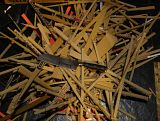
- Cuisinart Santoku
- Henckel's Twinmaster
- Chicago Cutlery Chef
- Everyday Essentials Chef
- Miyabi 7000 D Chutoh
This review consists of :

|
Knives :
This review consists of : |
A few specifications :
Initial impressions :
 The Cuisinart was decently sharp but very inconsistent.
The Cuisinart was decently sharp but very inconsistent.
In the sharpest sections it was among the sharpest knives seen in its price range but in the duller sections it was among the worst. It also had several small sections of damaged edge as noted in the picture on the right (50x magnification).
Moving beyond numbers, in the kitchen it could not push cut a tomato however it easily made unassisted slices. A difference could be seen against a freshly sharpened Miyabi 7000 D Chutoh which could continue to make unassisted cuts when the Cuisinart would start to just push the tomato around. However outside of some very careful attempts to examine the difference and/or an extremely high demand/tolerance for sharpness it would be unlikely for most people to see the difference. Of course there are still other issues with the steel :
Cutting ability : in general the cutting ability is among the highest seen in the inexpensive knives as it has all the required attributes :
Wedging : the grantons on the edge did not appear to do anything productive in regards to wedging. On sticky foods such as starchy potato the slices stuck to the sides as would be expected on any full flat grind of similar finish.
Point : the point is one of the weak points of the design compared to a traditional chef's knife but of course much more capable than the cleaver. It has a very wide point so precision cutting is much less capable but it is more suited to heavier work and easily popped apart frozen meats and vegetables which would be not practical for a very fine tip such as on the Everyday Essentials Chef's knife.
Utility : similar to the point, the general utility is between a chef's knife and a cleaver, much closer to the chef's knife. It is awkward to use for peeling but still functional and it has enough weight to do heavier work without concern. The main concern would be that as the edge is very thin it isn't suitable for heavy bone cutting. The upper limit of the work done with it would be heavy fish work which it did without problems (cutting five lbs salmon, cod, etc. into steaks).
Comfort : The grip is well contoured, of decent length and the only sharp edges, which are not really sharp, are at the heel and front of the bolster. The blade is also neutral balanced so sits very fine in a pinch grip around the front of the blade.
Security : the handle is a little slippery when greasy and as it is fairly oval in shape it can twist/roll a little in fairly demanding work such as working on large fish. If it was going to be used for such work on a regular basis then likely the grip should be checkered assuming a non-traction glove was not going to be used.
Durability : The grip is one of the most durable seen to date. It resists scratching, cuts and abrasion very well and even exposure to open flame for five seconds does not ignite or melt the grip. It also was not significantly effected by mild exposure to detergents or even harsh chemicals such as bleach.
Cleanup : There was no absorption of any materials by the handle and it easily is wiped clean.
The Cuisinart Santoku was used in the kitchen for ten weeks as the only knife before the edge no longer had the aggression required to slice a tomato without multiple dead draws. This puts it in the upper end of the performance for edge retention edge retention. in inexpensive kitchen knives. As always there is a lot of variability in kitchen use but the long trial (2.5 months) does allow a decent level of averaging.
During the work there was no significant damage noted, the edge simply slowly blunted. The only real issue noted was that the edge flattened in a few sections close to the tip so the blunting was not even. However with all runs on initial edge retention there would be expected to be a lot of variability as influenced by the quality of the initial edge and the exact work done in the kitchen as some work such as breaking down chickens can vary significantly from one to the next depending on how much bone is cut.
 In the stock cutting on cardboard the performance of the Cuisinart Santoku was
consistent with the other inexpensive stainless steel kitchen knives. No :
In the stock cutting on cardboard the performance of the Cuisinart Santoku was
consistent with the other inexpensive stainless steel kitchen knives. No :
The Santoku was one of the easier of the inexpensive knives to sharpen. Using the fine side of an inexpensive hardware store benchstone it easily took a shaving edge which would push cut newsprint with the blade on an initial 45. Slicing berga spinning thread under 40 grams of tension it would readily take an edge which only required 0.10 cm to make a cut, this put it consistently among the top of the inexpensive knives.
To be specific :
 The only issue with the sharpening was that the edge tended to on occasion
have large pieces torn out of the edge. Now to be clear this was sharpening
with :
The only issue with the sharpening was that the edge tended to on occasion
have large pieces torn out of the edge. Now to be clear this was sharpening
with :
Comments can be emailed to Cuisinart Santoku (intro)
and/or the YouTube Playlist for Kitchen Knives.
Most of the pictures in the above are in the PhotoBucket album.
| Last updated : | 09/01/2013 |
| Originally written: | 11:29:2011 |